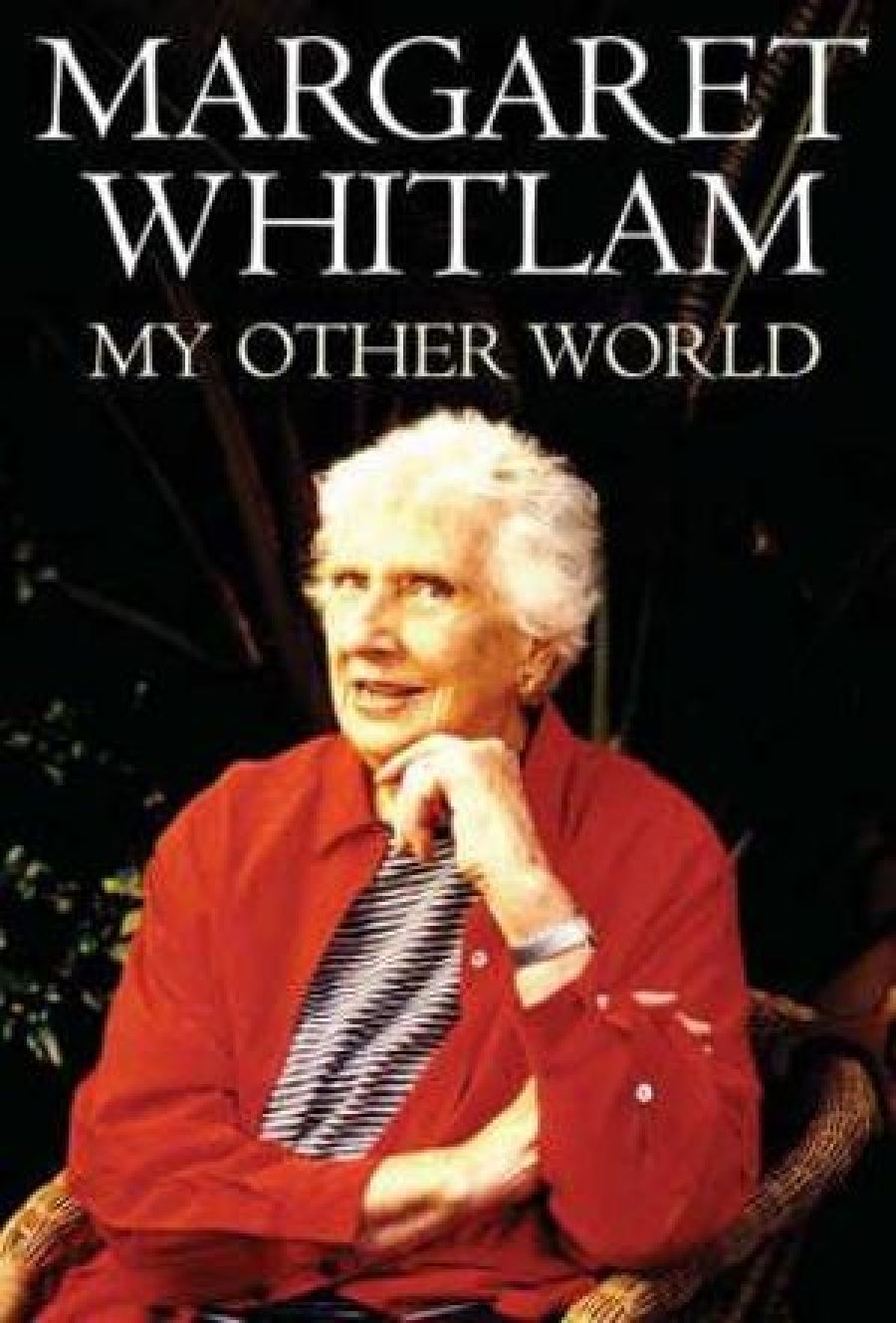
- Free Article: No
- Contents Category: Memoir
- Review Article: Yes
- Online Only: No
- Custom Highlight Text:
This book, My Other World, is in Margaret Whitlam’s words, ‘the story of my travels as the leader of group study tours around the world’ in the 1990s. It is also another episode in the life journey of a remarkable woman who has the capacity and the vitality to go on inventing new lives. Previously a swimming champion, social worker, suburban mother, prime minister’s and ambassador’s consort, advocate for adult education, Margaret Whitlam in her seventies embarked upon a new career as a travel guide, leading her companions not only into Britain, France and Italy, but also into China and Central America and the Russia and Siberia of the early 1990s. Now in her eighties, she has begun another life, writing her first book.
- Book 1 Title: My Other World
- Book 1 Biblio: Allen & Unwin, $29.95hb, 234pp
- Book 1 Readings Link: https://www.booktopia.com.au/my-other-world-margaret-whitlam/book/9781865087818.html
Since the beginning of mass travel, the cognoscenti have attempted to distinguish the true traveller from the mass tourist hurtling from place to place in the much-derided coach. But in recent years, group travel has gone upmarket with the growth of niche and boutique tourism, and now includes tours organised by art galleries, museums, university adult education departments, and companies that specialise in cultural and study tours led by celebrities and experts. This was the terrain of the Whitlam tours: A Literary Tour of England, A Study Program in China, A Cultural Tour to Europe.
As Margaret Whitlam points out, group travel offers advantages over individual travel: access to normally unavailable sites, dinners in exotic settings, meetings with local notables, special performances. The previous Whitlam lives opened doors for their fellow travellers to meetings with ambassadors, mayors and other public figures. Only rarely do hints emerge of the Whitlam life that preceded the tours; when describing a group visit to the Peggy Guggenheim Gallery in Venice, Margaret Whitlam observes that the gallery had been much ‘done up’ since their last visit, when with Paul Newman, Joanne Woodward and Gore Vidal they had shared Peggy Guggenheim’s eightieth birthday cake.
Travel has always spawned travel writing, the genre most open to those without ambitions to the identity of writer. The travel diary was for a long time a de rigueur gift to the departing traveller. If entries in diaries grew briefer as travels progressed, the weekly letters home, with explicit or implicit instructions that they be kept, provided a written account of places, events and adventures. In the nineteenth and well into the twentieth century, these letters and diaries were circulated among relatives and friends, and many found their way into print in local newspapers, magazines and book form, usually carrying modest disclaimers from the authors.
My Other World belongs to this genre with its unpretentious evocation of places and its snippets of information on historical and cultural associations interspersed with descriptions of hotels and restaurants, concerts, wayside picnics, brief vignettes of tourist guides, coach drivers, people encountered on the road and fellow travellers. In the half page on the German city of Wittenberg, we learn that the wooden doors on which Martin Luther nailed his ninety-five theses have been replaced by the more imposing bronze, that beside the church sits the castle which inspired Luther’s most famous hymn, ‘A Mighty Fortress is Our God’, that the group lunched in a café on the specialities of the region – potato cakes and smoked salmon and salad – and that in the women’s public loo one is allowed little more than a minute after paying a Deutschmark before the attendant walks along the corridor blowing a whistle and announcing that it is time to leave.
Margaret Whitlam is a sharp-eyed but ever charitable traveller. She shares with us her own pleasure and that of her companions in Wordsworth’s Lake District, Bach’s Leipzig, the Jesuit missions at Iguazu Falls. Serious travel has always been linked to painful or laborious effort, and travellers’ tales, even in modern times, must include incidents of adventure and inconvenience. Thus, Whitlam’s story not only describes churches, concerts and museums, but also interminable airport delays in China, riots in the streets and holdups in Central America.
Margaret Whitlam’s consort accompanied her on many of the tours, thus giving the participants the benefit of his encyclopaedic knowledge of history and readers of her book access to her wry understanding of the Great Man, who warmly responded to waving cheering crowds as he descended the main staircase of the Bolshoi Theatre in Moscow, unaware that the bald head just ahead of him was that of Mikhail Gorbachev. While Gough may normally be centre stage, in this book his is the supporting role. But then, in Australian writing on travel, women have predominated as the tellers of the tale.
What comes through in Margaret Whitlam’s ‘record of people, places and provisions’ is the verve, the energy, the curiosity and down-to-earth good humour of the writer, her enjoyment of not only her other world but also its people. Her book feeds nostalgia for the places that readers have visited and curiosity to explore those they have not. It leaves a lasting impression that it must have been great fun to have travelled on one of the Whitlam expeditions.


Comments powered by CComment